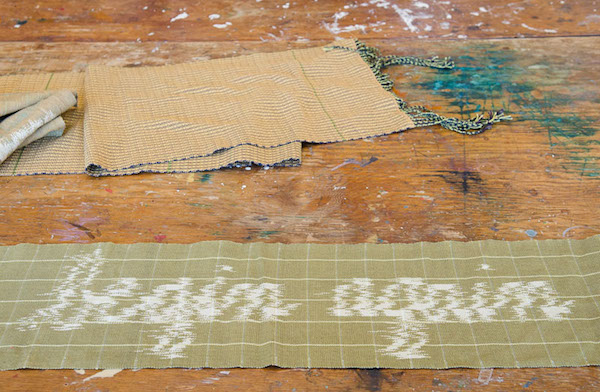Begin again. Two words woven into fabric. The weaver is Amanda Thatch. The words belong to her and, as with any communication, quit belonging to anyone the moment they are formed.
Amanda is alive to this fact. As one of Penland’s most voracious readers, she’s interested in language as its own material. In her recent work, words, prefixes, and suffixes surface in the fabric. Text in textile. It’s a linguist’s dream: “text” appears in English from French and Latin, and in “textus,” we have the printed word and its style; “texture” and “textile” deriving from the Latin “texere” (to weave). Writer and weaver have long been in etymological entanglement.
In Amanda’s textiles, textual elements blur and waver. She ties the warp threads to create the letters; they resist the dye. The result is clear and distorted. You can run your hand across the fabric but someday the suffixes above may be cut and displayed separately.
Last summer, Amanda played with ikat–tying the warps multiple times to make these pieces. She doesn’t have the heart to place them behind glass yet. Or iron them, for that matter. “I’m attracted to things that are problematic to presentation,” she says. “Books and textiles.” Works that need to be touched and have a history of being touched. An invisible history.
Begin again.
If I could begin this essay again, I’d start with the term “resist,” and how, in order to be visible, the words Amanda intends to make in fabric must hide from the dye. Then each thread is woven and, Amanda reminds me, thought about as a group performing the structure. The process takes forever, if by “forever” we mean more time than most things take. There’s something spectacular about the weaver in the age of the IPhone. Tedium and loneliness are givens; the loom’s technology provides for an embodied solitude. Hours of it. Alone with warp and weft.
“I don’t like it when I can’t touch the material directly, and I’m not interested when I can’t see the material transform,” says Amanda. “Or when, as with clay, substance goes through a hypermaterial change I can’t touch. I don’t want to give that control of material over to the kiln gods,” she says.
“For me,” Amanda says, “it’s all about the loom. Maybe I should have been an organist?” she quips.
“Only lonesomeness allows one to experience radical singularity, one’s greatest dignity and privilege,” writes novelist and essayist Marilynne Robinson, a writer important to Amanda. When I look at Amanda’s fabrics, spread across the table, I think of Robinson. It’s hard for me not to. In this short essay, my essay, Amanda Thatch and Marilynne Robinson text each other without using phones. One, in Iowa, writes a sentence in a book. The other takes her hands to a loom overlooking the Blue Ridge Mountains. It’s winter. Both believe in the “radical singularity” to be experienced in art and solitude, in reading, in the act of thinking, writing, weaving.
Begin again.
Amanda, does the imprecision of language disturb you?
[Amanda laughs.]
“What’s disturbing to me is to be a singular consciousness,” she says. “I want a possibility of communication that’s complete. But it’s not possible. Apart from regular speech, I think there’s a role that art plays in bridging the gap.”–Elaine Bleakney
Amanda Thatch is a former core fellow and the Textiles, Painting & Drawing Studio coordinator at Penland. View more of her work here.
Photographs by Robin Dreyer.




